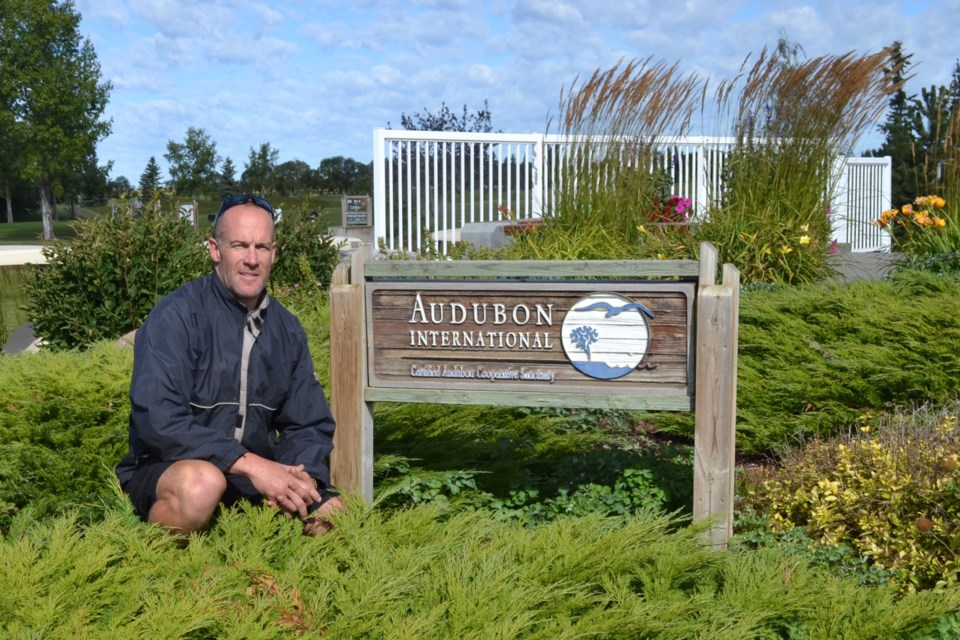OLDS — Olds Golf Club has reached a big milestone.
It has now been certified for 10 years as an Audubon cooperative sanctuary through the Audubon Cooperative Sanctuary program for golf courses.
Jason Clouston, the Olds Golf Club’s course superintendent, is proud to have achieved that milestone.
“I think it’s exciting for Olds Golf Club. I think it’s exciting for golf in general to have golf courses that are achieving these high levels of environmental stewardship," Clouston said during an interview. He’s been with the club for about 20 years.
“I think it’s important. I think as we move forward, that’s what the world wants, is more environmentalism," he said.
“I think golf courses do a really good job of being environmental stewards to start with. It’s just that we don’t get recognized for it and we don’t document it.
“And that’s kind of what this program is – we’re just documenting all the stuff that we do. And then they evaluate you on that and if you achieve all these areas to a high enough standard, then they’ll certify you."
He noted only 21 golf courses in Alberta are certified as Audubon cooperative sanctuaries. The Olds Golf Club is No. 13.
At first certification seemed like a daunting task.
“When I first started looking at it about 15 years ago, I almost thought it was unachievable for the size of this golf course,” he said. “Then we just started working through it and I went, ‘hey you know, I think we can do this.’
“And it’s incredible to be now 10 years certified. We certified the first time to be a member and then we’ve (been) recertified twice.”
In order to obtain certification, a course must pass muster in six areas, including environmental planning, wildlife and habitat management, safety and reduction of chemical use, water conservation, water quality management, as well as outreach and education.
Golf course personnel must develop and implement an environmental management plan, document the results and host Audubon international staff as they conduct a visit to the course.
In order to maintain the certified sanctuary designation, the course must be certified every three years.
Efforts club staff have undertaken in order to be certified include naturalizing 23 acres of rough, creating wildlife habitat that has attracted birds, ducks, geese, rabbits and even moose.
For many years – except this one, due to COVID concerns – Grade 3 students have come out to the course – and course staff have come to schools – to build bird houses that have then been placed in the golf course.
The students have come out and watched birder Dick Stauffer has he has banded those bird to track their travels.
Plans are now afoot to partner with Olds College to study the ability of some wetland plants to sequester pollutants from run-off water.
They’ve also utilized new technology to make the course more efficient; for example, using sprinkler heads to ensure they only water the grass and not waste it by also sprinkling nearby roads.
They also use technology to carefully monitor evaporation and transpiration of water (how plants suck up water).
They also only spray chemicals where they’re needed.
“We go out and we scout the golf course and see what’s out there,” he said. “In the old days, for instance in agriculture, if there was one weed in the middle of a field, what would they do? They’d till the whole field. My theory is why not just walk out in the middle of the field and pick the weed?
“So we definitely do spray, we just manage where we spray. We might not spray the whole golf course. We might just highlight an area that’s bad and spray it. So that’s kind of the theory.
Audubon International CEO Christine Kane said in a news release: “Olds Golf Club has shown a strong commitment to its environmental program.
“They are to be commended for their efforts to provide a sanctuary for wildlife on the golf course property; especially their efforts in creating wildlife habitat in a predominantly agricultural area.”
Clouston said it’s all about walking a fine line between providing a top quality golf course yet also doing so in an environmentally friendly way that attracts and preserves wildlife.
According to Clouston, the bigger courses in cities with much bigger budgets are the ones that tend to get certified.
He said those big clubs tend to have budgets of $1 million or $2 million, while he estimated Olds’ to be only about $600,000.
“So we’re probably for sure half the budgets of some other places, but we’re able to compete with them but also achieve this status,” Clouston said.
“I think it’s good. I mean, I don’t really see there being any reason why even nine-hole golf courses can’t (do this). It doesn’t cost a lot of money other than the fee every year to do it.”



